Reiner Knizia is one of the most prolific game designers around. His author page over at BoardGameGeek has a Top Games section with 717 entries as of this writing. Obviously, with such a long list of games written, some hit amazing highs (e.g., Ingenious, Ra), while others fall flat (e.g., At the Office, Into the Blue). Regardless of the level of fun and engagement, some have called his games “an interesting scoring system and mechanics draped lightly with a paper-thin theme” (thanks KMortis!). Even as a fan of his work, I have to say that this is a decent description of many of his games.
There are a few of his games that, honestly, define what I love about board gaming. Blue Moon is one such game. But before we delve into the plight of the Holy City of Psi, let’s take a quick trip through the history of how the game was released.
Releases
Blue Moon is a two-player card game. It was initially released as a base game with two factions: the Hoax (wise scholars and librarians) and the Vulca (magicians of fire and passion). This box contained a pre-constructed deck for each faction, a game board, three dragon figurines used for scoring, and a rulebook.

To emphasize the customizability of the decks (once you had more cards), each of the pre-built decks included a few cards sprinkled in from other factions. This also hinted at the scope of this game (just how many factions would eventually be available). The game has rules for how to customize one’s deck, making this an interesting marketing move.
Later releases added new factions with their own pre-build decks. These included:
- the Aqua – water people who have retreated from the rivers and lakes to the sea
- the Buka – seafaring pirates loosely organized into families
- the Flit – bird people who control the skies
- the Khind – youthful and mischievous troublemakers (essentially the Lost Boys in Peter Pan)
- the Mimix – free people who occupy the wild places and commune with nature
- the Pillar – nomadic traders who only wish to see the conflict come to an end
- the Terrah – hard working people of the earth
Once you had all the expansion sets, you had all the base cards for each faction. Since each pre-build deck has a few cards from other factions, you could not get all the cards for a specific faction unless you purchased those expansions as well.
In addition to new factions, there were a couple of expansions that had some unique cards that fell into areas outside of a particular faction’s feel. These sets included cards from a couple of minor factions (the Hyla who can influence the game, and the Tutu who can add strength at a cost). These sets added cards that could interrupt a player’s turn, and added crystals that could alter the scoring at the end of the game. They were:
- Emissaries & Inquisitors – Allies
- Emissaries & Inquisitors – Blessings
And lastly, there were some rather difficult to get promo-cards released:
- Earth Spirit
- Fire Spirit
- Sea Moon
- Water Spirit
- Wind Spirit
All of this results in a tremendous number of cards, making for a plethora of possible decks!
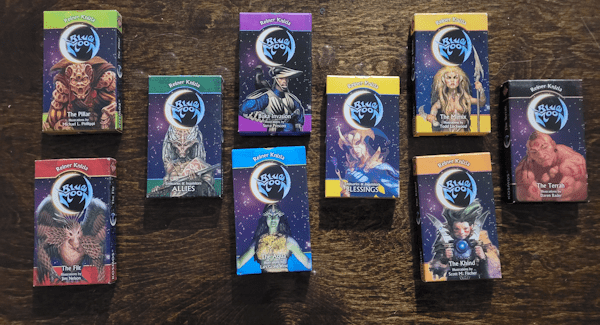
Blue Moon was released in 2004. Expansions and promos were released between 2004 and 2006. Almost a decade later, in 2014, Fantasy Flight Games released Blue Moon: Legends, a box set that contained every card that had been created – base, expansion, and promo. The cards were reduced in size, but everything was there, including a combined rulebook making the game more approachable than ever before.
Legends
When you get Blue Moon: Legends, you get the contents of everything listed above. The complete component list is:
- Rulebook
- Advanced Concepts book
- Game Board
- Dragon figurines ×3 (in red, green, and blue)
- People cards ×296
- Mutant cards ×10
- Crystals ×9
- Interference cards ×7
- Hyla cards ×8
- Tutu cards ×8
- Emissary cards ×4
- Inquisitor cards ×4
- Spirit cards ×4
- Achievement cards ×3
- Element card ×1
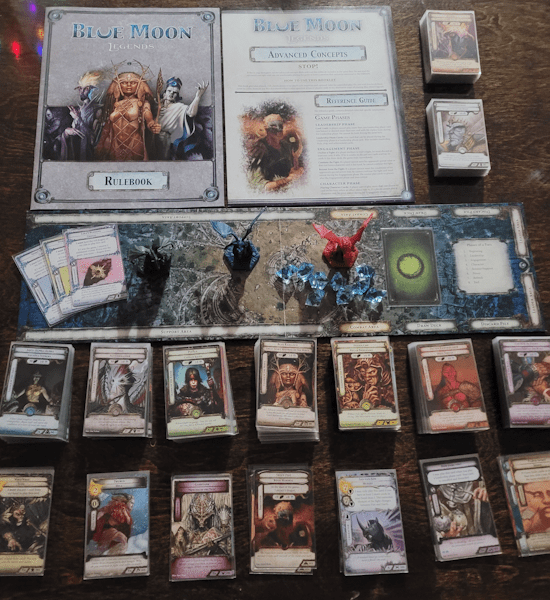
A General Overview
Blue Moon is played in a series of fights where players ratchet up the power on their side of the fight. Power is dependent upon the element in which the fight is taking place (either Fire or Earth). Moving the power level up requires that a player have character cards (a lack of characters to play will cause a retreat and a loss of the fight). Power level is the sum of the power of the current character, plus any boosters and support cards the player has in play.
When a fight is won, the winning player will move one (or more) dragons either from their opponent’s play area into the neutral zone of the board, or from the board into their play area. Once the end of the game is triggered, the player who controls the most dragons wins.
Getting into the Nitty-Gritty
If you would like to get into the details on how Blue Moon is played, click on the link below. If you would rather just get to my thoughts on the game, skip this section and continue reading my thoughts below.
The Anatomy of a Card
Before we delve into how to play Blue Moon, it is important that we know the anatomy of a card. Each card has the following elements:
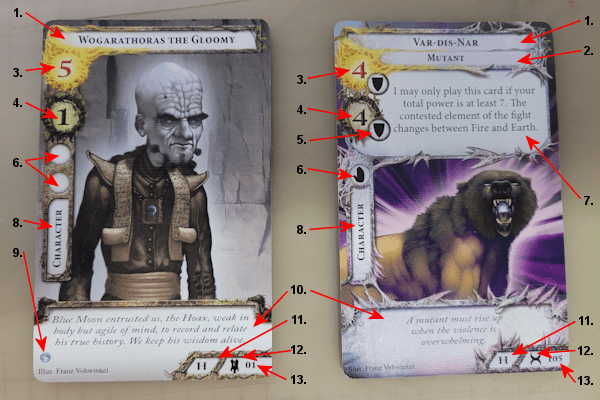
- Name of the card
- Title of the card (optional)
- Power in fire
- Power in earth
- Shield icon(s) (optional)
- Other icons (optional; up to two)
- Special power text (optional)
- Type of card
- Moon value
- Flavor text
- Deck indicator (optional)
- Affiliation symbol
- Card number
The three most important pieces of information on the card (as far as gameplay is concerned) are the two power values (fire and earth) and the special power text.
The special power text is something that needs a bit of explanation: the way the text is written is for it to be read aloud to your opponent when you play the card. So when you read Var Dis-Nar’s special power text above (“I may only play this card if your total power value is at least 7. The contested element of the fight changes between Fire and Earth.”), the “I” refers to the active player who is playing the card, the “your” refers to the opponent who is not playing the card. This is an odd structure, but it becomes second nature after a few cards.
Playing Blue Moon
The original core set had the Hoax and the Vulca; the Blue Moon: Legends rulebook suggests that these are the two decks you start with – thus ignoring all of the advanced concepts that came with sets such as the two Emissaries & Inquisitors expansions. This is very good advice! You could substitute some of the other pre-built decks for a relatively smooth introduction, but I would strongly suggest not including the Buka while first learning the game.
Setup is quite simple: place out the board and place the dragons on it, reveal your Leader and place it near the board in the designated space, shuffle your deck (30 cards) and place them in their designated space. Each player draws six cards and they randomly determine the first player. You are ready to begin!
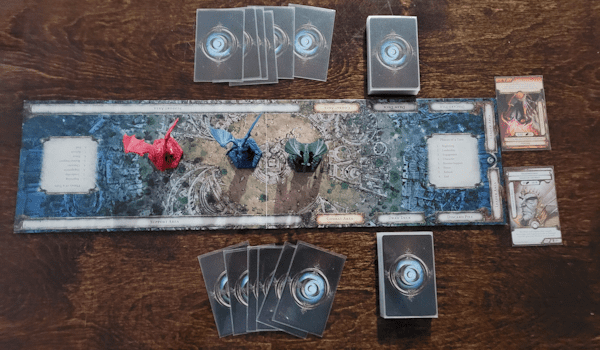
Blue Moon is a series of fights. When a fight begins, it will start with a character card being played. The player playing this card will declare which element is being contested (i.e., either Fire or Earth). Unless some other effect states otherwise (e.g., a Mutant is played), the fight will continue in that element until it is won.
The phases of each turn are printed on the board (twice, so each player can see it and not have to read it upside down). The turn sequence is as follows:

This is not as much as it might first appear. The Beginning, Leadership, Booster/Support, and End phases will have nothing happening in them most of the time. The bulk of the game is Engagement, Character, Power, and Refresh.
- Beginning: both players resolve powers on cards in play that indicate they happen at the beginning of a turn. Most of the time, nothing happens in this phase.
- Leadership: the active player may play one Leadership card from their hand, if they wish. They will resolve this card immediately. Leadership cards can have instant effects, or effects that last through a turn. They will never have an impact that lasts longer than that.
- Engagement: this phase has two possibilities: there is an existing fight, or there is not an existing fight.
- If there is no existing fight, the active player may either start one (i.e., they will play a character card in the next phase); or they may decline to start one, in which case they discard 1-3 cards from their hand and proceed immediately to the Refresh phase (their turn is over).
- If there is an existing fight, the active player may continue the fight (i.e., they will play a character card in the next phase) or retreat, in which case their opponent has won the current fight and the game steps out of the turn sequence and enters a special ‘dragon’ step to resolve the conflict before the next fight can begin.
- Character: this is the main phase of the game. The active player plays one character card to either start a fight or to continue the existing fight (see Engagement, above).
- Booster/Support: the active player may play one booster card or one support card if they wish. If this is the first turn of a fight, the active player cannot play cards in this phase. Booster cards are one-turn boons; Support cards can continue until the end of the fight.
- Power: the active player announces their total power value in the current element. If this is the first turn of a fight, the player may select either element; otherwise, they will continue in the current element.
- Refresh: the active player draws cards from their deck until they have six cards in hand. If they have six or more cards in hand already, they do not draw.
- End: both players resolve powers that indicate they happen at the end of a turn.
The Engagement phase is quite critical! It is in this phase that a player needs to determine if they have cards in their hand that they can (and want to) play that would result in a power that is equal to or greater than the current power of their opponent. If the answer is “yes,” they can start or continue a fight; if the answer is “no,” they must decline or retreat.
Your current power is the sum of the printed power on your current Character card for the element being contested, plus the printed power on all current Booster/Support cards for the element being contested, plus the effects of any special powers that may be in play.
Example: let us suppose you are playing the Vulca. The current fight is in the element of Earth and your opponent announced a power of 4 on their turn. You have Lightning Bolts in your Support Area (Earth power 1). Looking at your hand, you see that you can play the character Spark (Earth power 2) and a booster card Fireblast (Earth power 2) and announce a power of (2 + 2 + 1) 5.
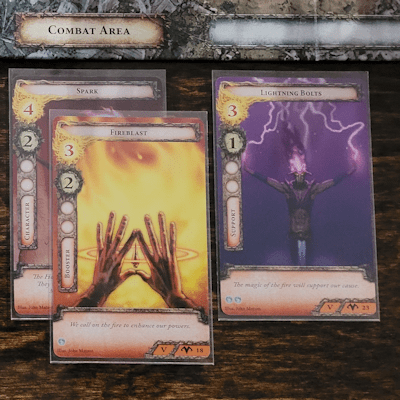
As indicated above, once someone has to retreat, the game steps out of the normal sequence and has to resolve the fight. There are four steps to this:
- Dragon step: the player who won the fight attracts a dragon (two dragons if they have six or more cards in their combat and support areas). If any player has three dragons on their side, the game is over and they have won.
- Discard step: both players discard all cards in their combat and support areas. Any active Leadership cards are no longer active.
- Refresh step: both players draw cards from their respective decks until they have six cards in hand. If they have six or more cards in hand already, they do not draw.
- End step: the current turn and fight are over. The retreating player begins a new turn (as above).
Attracting a dragon means that a dragon moves one step toward the winner. There are two places a dragon can be when it is attracted:
- If the opponent has one or more dragons on their side, attracting a dragon means moving a dragon from their area to the central area (the board) where the dragon becomes neutral.
- If the opponent does not have any dragons on their side, attracting a dragon means moving a dragon from the board to your area.
The game ends if a player has three dragons on their side of the board, or a player has no cards remaining in their hand and draw deck. The player with dragons wins.
Oh So Much More!
Above is a basic rundown of the game. But there is more. Much more.
There are icons on cards that change how they work:
- Bluff (question mark) indicates that the card can be played into the support area as a card with a power of 2 in the contested element. Players may play cards this way that do not have the bluff icon, however the opponent can call the bluff. If any cards are shown to not have the bluff icon, things can get dicey…
- Free (star) indicates that the card does not count toward the card playing limit (i.e., one character card, one booster or support card).
- Gang (stylized G) indicates that there are one or more cards with the same first word in their names. Any number of these cards can be played together as a single entity (adding their power together).
- Pair (two faces) indicates that there is another card with the same first word in its name. These two cards can be played together as a single entity (adding their power together).
- Protect (helm) indicates that the card is immune from opposing effects. The card cannot be ignored, discarded, or targetted in any way by the opponent.
- Replace (double-arrow) indicates that the card can be discarded from the player’s hand during the Leadership phase to draw a new card from their deck.
- Retrieve: the retrieve icon (an arrow) indicates that at the end of the turn, during the End phase, that card is returned to the player’s hand.
- Shields: some cards have a shield icon next to one or both power values. When played, this indicates that the player can ignore their opponent’s power value for that power phase. This allows a player to drop the power value down.
- Stop: the stop icon (a hand) indicates that, once played, no further cards can be played that turn.
There are special types of cards that can be added into the mix. If these are used, it must be with both players agreeing to use them:
- Emissaries alter the way the decks are constructed.
- Hyla are special influence cards (see below) limited to one in play at any time. If a new Hyla card is played, the previous one is placed into the owning player’s discard pile.
- Influence cards have effects that are not discarded at the end of a fight.
- Inquisitors alter deck construction much like Emissaries. They, however, also include Special Power Text which is always in effect for the game.
- Mutants are special character cards that, when played, will switch the element being contested (i.e., from Earth to Fire or vice versa).
- Ships are a part of the Buka. These cards can move cards into and out of the fight.
Players can play a match of multiple games where the winner gets one crystal for winning, plus an additional crystal for each dragon they control at the end of the game. Matches are played until someone has 5+ crystals. When playing matches, Achievement cards can be added – these cards act like Leadership cards with Special Powers.
In addition to the pre-constructed decks, players can build their own deck. A deck begins with the Leader card – which indicates the baseline cards available. In addition to the cards from the faction of the Leader card, players can include cards from other factions: the limit here is the Moon Cost (see Anatomy of a Card, above). No deck (unless an Inquisitor or an Emissary states otherwise) can include cards from other factions with a total Moon Cost of greater than 10.
In other words, there is a lot going on here.
Thoughts on Blue Moon
Blue Moon is an amazing and interesting game. Although the deck construction rules are much more restrictive than in games like Magic: The Gathering, the game has often been compared to that 800-pound gorilla of Collectable Cards Games (CCGs). This despite the fact that Blue Moon is not a CCG. The decks in Blue Moon are customizable, but in a restricted way. Each faction has a leader card and 32 other cards (except the Buka who only have 31); there are a wide variety of other cards from the Emissaries & Inquisitors expansions and the promos. The number of ways you can surprise your opponent with cards outside your declared faction’s baseline is tremendous!
This is a game that you will be playing and suddenly realize some subtlety that you had missed in your previous plays, even if you have been playing it for a long, long time! This subtlety is one the things that I love about this game: it sneaks up on you.
When I first started playing the game, I was looking to defeat my opponent in each fight as fast as I possibly could! Jump up to high power levels quickly, and force them to retreat. This is a strategy that will get you ahead in the short term; but in the long term, you will run out of steam. Besides, if you can draw out the fight long enough, you can double your rewards and get the most of your boosters and support cards. So I started learning how to slow down.
When I first started playing the game, I looked at the cards and it seemed to me that keeping my cards in the base faction was best – those cards are designed to work together. But as I played, I learned that having some small element of another faction or two can be helpful in many ways, not the least of which is surprising your opponent who may not be expecting some tactic from the Mimix when they first saw that you were playing with the Tera. Another great thing is that some effects, in small doses, can create synergies that you may not be able to get from the cards in a single faction. Discovering these, when I manage to do so, is a joy!
Blue Moon is a game that deserves a far larger fanbase than it has ever had.
Thoughts on Blue Moon: Legends
I have been called crazy for the fact that I own five complete sets of the original version of Blue Moon. I owned two copies of Blue Moon: Legends (my sister ‘forgot’ to return a set to me when I was moving). The Legends release is one of those things that got a lot of things right. For example:
- All of the cards (be that cards from the core set, the expansions, and even the promotional cards) are included in the box.
- The dragon figurines are amazing, especially when compared to the ones that came with the base game.
- The crystals are large and chunky.
- They included a card with the fire and earth symbols on each side so that you could have a visual aid telling you which element was currently being contested.
All in all, I have one and only one complaint: they reduced the size of the cards from the Tarot card-size of the original to a much smaller format:
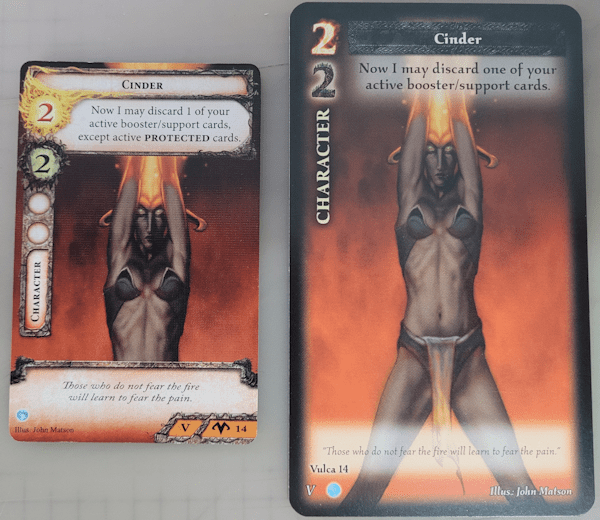
There are elements of the new card framing that I like such as the way the power levels, icons, and card type are separated and made cleaner. I like the way the special power and flavor text is segregated and placed onto a solid-color background. I love the additional information at the bottom of the cards that allow you to not only know which faction a card was from, but if it were included as part of a pre-constructed deck, which one (even if that were in a different faction).
But in the end, the reduced size means that all of those elements are smaller and harder to read. It also means that the gorgeous artwork has to be cropped in order to fit onto the new card. Given the beauty of that artwork, this feels like the wrong choice to me. Add to that the enormity of the box, they certainly had space to make these cards the original size.
Final Thoughts
Reiner Knizia has said that, of all the games he has designed, this one was the hardest to get balanced correctly. I have absolutely no doubt that is true. Blue Moon is a nearly perfect game. It is one that, once you sit down with the cards, takes only a few minutes to figure out what you are doing. But it is also one that will take many, many plays in order to pull out the nuances of its strategies. And they are numerous! If you start playing this game, plan on learning and discovering new things about it for years on end.
Best I can tell, this game was not a huge success for Reiner Knizia or its publishers. That is just sad. This is a wonderful tabletop experience that I am constantly discovering more and more about!


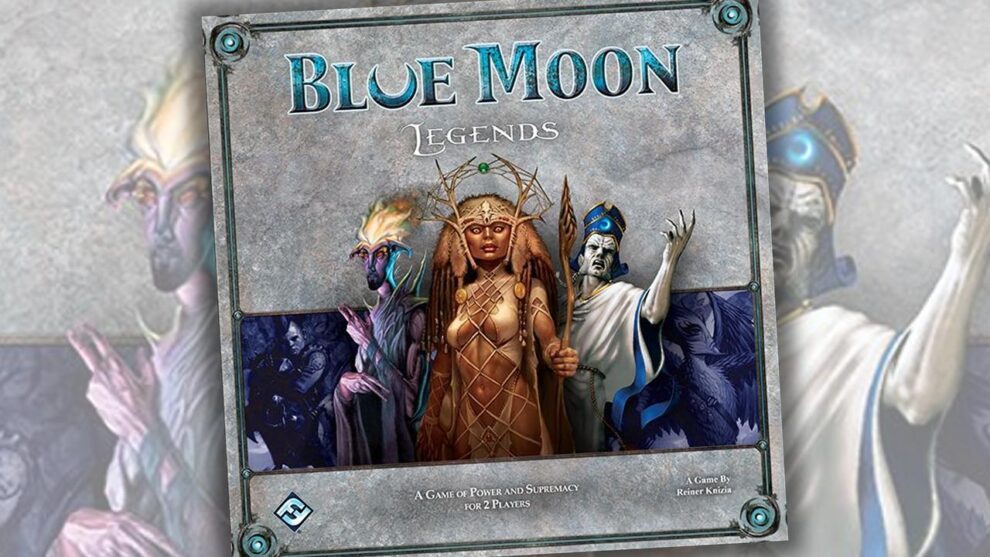

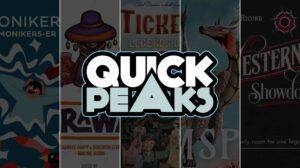






Thank you very much for this detailed review and tutorial. I had read this article a while back when a private seller had it for sale, but for more than I was willing to pay to figure out if I would enjoy the game. But your article kept Blue Moon on my radar. When I saw the seller heavily discounting his price I jumped on it. The game was a little confusing to learn, but then I remembered your webpage. I’m going through it carefully these days before I introduce the game to friends. Thanks!